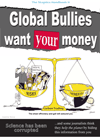By Jo Nova
Thanks to Elon, many people are wondering “Why Mars?” and the answer might be “mining the asteroids”
Devon Eriksen has the best answer I’ve seen. He compares the race to space with the industrial revolution. Just as wood, coal and oil set us free of lives of manual labor, a whole new set of materials beckon… if minerals that are rare and expensive on Earth can be mined in the asteroid belt, and processed on Mars, all kinds of new tools and toys may follow the boom.
The Earth, Eriksen says, is like a jar that’s been shaken until most of the heavy stuff settles to the bottom. The heavy metals mostly end up in the Earths core, with the lighter stuff on top. But apart from the distance, asteroids have easy access goods, and are split already into handy size chunks, conveniently parked out in the open, far from gravity wells and not hidden under crustal plates, oceans and magma. The rocks under our feet are so much closer but there is a whole planet in the way. It might be a lot cheaper to get the rare metals we need on asteroids than out of our core.
The 16-Psyche asteroid is one of the bigger ones, at 279 km across, or 173 miles, and spectroscopic analysis and radar indicates it’s mostly metal. Judging by other bits of meteorites that fall on Earth, speculation is rife that Psyche contains nickel, iron, and things like palladium and platinum, but of course, no one knows.
Humanity has collected so far all of 255 grams of asteroid space rock (5g from a Japanese launch and 250g from NASA). But China plans to launch Tianwen-2 next year and collect samples from the near-Earth asteroid Kamoʻoalewa.

16-Psyche asteroid, theoretically (possibly) a mine worth $100 Quadrillion dollars (Image: NASA/JPL-Caltech/ASU)
The race is on:
The Trillionaires of Mars
By Devon Eriksen, Substack
The first entity to establish a Mars colony will be the universe’s first trillionaire
Earth is a metal-poor, heavy-element-poor environment.
We just don’t think of it that way because it’s what we are used to. And it’s a major bottleneck holding our industrial development back. Not because these elements will run out, but because the expense of extracting them limits availability, and drives costs up.
Well, the mass of the asteroid belt is roughly 0.05% of Earth’s mass. But, unlike the Earth, the asteroid belt isn’t a big lump of material, sitting in its own steep gravity well. It’s a powder. A spray of fine dust orbiting the sun. The largest asteroid is only about the size of Texas, and most are much smaller.
One single asteroid, 16 Psyche, some 140 miles across, has an estimated value at today’s market prices of 100 quadrillion dollars. You read that right. That’s roughly 900 times the value of the entire world economy.
On Earth we live at the bottom of a deep gravity well, and all the hard part of a journey to the asteroids is just getting out of the driveway accelerating at 10 meters per second per second. But Mars has a much smaller gravity well, and suddenly so much more interaction with space is possible:
… Mars’s gravity acceleration is about a third of Earth’s. A little over 3.5 m/s². Rocket science is not so difficult on Mars. [Closed caption for the hard-of-thinking: Devon is speaking comparatively. Rocket engineering is still difficult.]
So if you think SpaceX can move stuff to Earth orbit cheaply now, with their fancy reusable rocket boosters, and all their lightyears-ahead-of-NASA space tech, and their $2 million dollar Starship launches, you ain’t seen nothing yet.
On Mars, with its ⅓ gravity, and thin atmosphere, you wouldn’t even need a rocket to achieve escape velocity.
It’s the fact that here you have a planet, where people can live in sealed habitats (above or below the surface), and it’s really, really easy to throw things into space, and get them to and from the asteroid belt.
In other words, if Earth is the suburbs, and the Belt is the mine, Mars is your industrial zone.
Hell, you don’t even need to mine asteroids in place.
Depending on the delta-v cost, you can just attach boosters to your smaller rocks and push them right into Mars orbit. It’s called a Hohmann transfer. But whether you are moving metal from a mobile refinery, raw ore, or entire rocks, cargo is cheap to move in space, at least compared to space launch from Earth’s surface.
Space isn’t an ocean, you see. There are no waves, your cargo can’t sink, and there’s no air to slow it down. So you don’t load it up into a ship, and sail the ship somewhere.
There’s no place like space for those self-driving vehicles.
h/t to David E













I had about thirty second of skepticism — then I recalled 65 years of reading science fiction, and how many of the
fanciful, but not-in-violation-of-physics predictions have come true. In & around my college years, the first satellite
went up that allowed for a TV signal to bounce live from space for a few minutes. Now…..
We have satellite radio in our cars, starlink in our pockets, and gps is ubiquitous.
A settlement on mars is probably now just a set of engineering problems, and the cost is probably also manageable and predictable.
A pound of gold is worth about $32,000. Pounds of exotics have higher values. Delivery back to earth can use gravity for most propulsion and
a Rutan feather type vehicle to land on normal runways;
Regrettably, throwing rocks from space also becomes the top of the food chain weapons system; look for governments to be terrified as private development
proceeds and throw up all the roadblocks possible. A super-villian in space might indeed be able to blackmail the world. More life imitating art.
110
Gravity will not provide most of the propulsion to bring the metals back to Earth, not without complex slingshots around heavier masses.
An object orbiting the sun has a specific potential energy, due to the distance that it has to fall to the sun, same for the Earth. The object further out has higher energy.
To get the object closer in you have to lose that energy. The most direct way would be to place a rocket on it and slow the orbital velocity, if you time the burns and point the nozzle in the right direction, then you could bring the object to Earth.
It’s going to take a large rocket to bring the object here. It’s the same energy requirement to move a mass to an outer orbits as to bring it back, it’s just that the force will be in the opposite direction, eg a deceleration burn.
110
As evidenced just in the last few days as Earth’s mini moon departs. (well it came and went in 57 days anyway)
Sorta wonder why we didn’t grab hold of it when we had the chance. Must be cheaper to go to Mars and do it, eh!
Tony.
50
Basic question.
Do we have the technology to keep humans alive for long term in non-Earth (outside the Magnetosphere) interplanetary space?
AFAIK the Apollo missions ventured there for only short periods nearly a half century ago.
Nothing since.
I did notice SpaceX’s magnificent technological feat of rescuing the stranded ISS astronauts complete with a capsule splashdown …
just like 1962.
Sorry, a Mars colony is in my same brain file as my George Jetson flying car and my Moon vacation.
I shall wait patiently to be corrected with hopefully only the amount of derision appropriate to my NPC midwittery.
150
Correct Honk. One thing Earth’s explorers did not have to worry about was where their oxygen was coming from. No amount of technology will solve that problem in space. It will only take one accident, a la Apollo 13 for it all to fall to pieces.
60
And NASA was lucky that a solar flare didn’t go off. The less time above a protective atmosphere or under a large shield the better. Some of the atomic particles raining down on the top of the Earth’s atmosphere pack enough energy to be compared to a baseball at 100km/hr. I’d hate to have a little of my DNA hit by that.
It takes kilometers of atmosphere to remove most of the cosmic rays, a few mm of aluminium sheeting will actually make it worse because of the particles that are created as the cosmic ray hits the aluminium and then they stream into your body.
40
Robotics is the answer, humans need not even go there if we develop hubots to take our place.
50
Bots?
10
Darth Vader has already beaten Elon in the race to Mars, according to your first picture 😉
50
I would imagine there might be a slight issue getting the completed heavy product in quantities from Mars back to earth.
40
Back to Earth?? Easier to move the humans to where the resources are and live there.
Would we really move metal back to Earth, have factories in orbit making TVs with it and then shipping them down for people to watch? I suppose the peasants get shipped off to the asteroid belt to mine and move material, and they’re the ones in permanent orbit making the products needed for the handful of trillionaires who live on Earth with their servants in vast natural estates..
“65 years of reading science fiction”.. yes, its thrown up a wide range of scenarios for just what we are seeing get started!
20
A space elevator between Mars and Phobus might hold the answer, the moon is locked in place and not far from the Martian surface.
10
Never stop dreaming, striving achieving. Progress is dependent upon materials and energy science and someday someone will likely stumble upon something which will eventually free mankind from a future resource deprived doomed planet.
or invent soylent green
20
I will take a post nuclear war ravaged, resources depleted planet that has a tolerable temperature and breathable atmosphere,….over Mars ,…….Every time !
50
All of this was covered in the late Dr Jerry Pournelle’s 1980’s book “A Step Further Out” which, though very dated now, I highly commend as a primer on the subject at hand.
40
First big problem is the length of time to and from Mars and eating out of tubes doesn’t seem to be very attractive for months or years between trips.
And what is the tonnage of the goodies you send back to Earth to be made into stuff for the buyers?
The whole operation doesn’t make much sense when the extremes of time are taken into account.
How many millions of $ do you pay the astronauts for each trip and many years of work?
You may also have severe health problems on Mars and perhaps a much lower life expectancy after you return.
I think boredom would be another problem and watching Netflix etc wouldn’t provide much relief.
40
Martian Uyghurs or humans with hay fever.
I suppose it depends on which nation gets there first.
30
I think it’s wonderful as long as the Left don’t turn it into some subsidy-harvesting scam funded by hard-working taxpayers. The Left mess up everything they touch.
Let free market forces operate and see what happens.
Personally, I wouldn’t want to live on Mars. It’s a cold, miserable, low gravity environment. Odd also that it’s so cold with an almost 100% CO2 atmosphere. Doesn’t Leftist “science” tell us it should be like a furnace? (Partial pressure CO2 on Earth 31.8Pa, Mars approx. 700Pa, solar insolation Earth 1350 W/m2, Mars 590 W/m2.)
Terraforming is a long term option but the Left are already trying to alter the climate on earth and spending trillions without success so why mess up another planet?
70
I think it would be cheaper to mine the oceans.
Maybe there will be money in the cleaning of all the filters from the desal plants? If only the manufacturers could get the filters to trap and hold onto a mineral of choice eg gold. Now that would be a win. The desal plants already exist, so do the filters and the energy to run them apparently. We just need that little tweak of the membranes.
Could be worth a grant or two. Where do I apply?
50
Might be cheaper, but not worthwhile. I remember the comic magazine covers of my childhood(*) saying something like 3 tons of gold per cubic mile of ocean. Back of the envelope calculation:
A mile is 1600m. Cubing that gets 4096 million m^3, i.e. 4096 gigalitres.
Sydney’s desal plant says it can produce “up to” 91.25 gigalitres per annum.
That means it’d take *45* years to extract 3 tons of gold. By contrast, the *annual* gold production of that gold-megaplayer New Zealand is 6.1 tonnes.
(*)A quick scan of the web for gold per cubic mile of ocean gave me figures between 25T and 50 lbs. I’ll go with the figure from the comics.
50
Onwards and Upwards and to Infinity and Beyond. I’ll be long gone by then.
30
Something like:
“Well may the meek inherit the earth,but the bolt will take the stars.”
I vaguely recall that bit of hopeful thinking is from a science fiction novel, but it could just as easily be credited to several astrophysicists.
Then again, if, as the ABCess et al are declaring, the jig is up in three years, humanity can die with a whimper or actually try something serious.
Once again: “The eco-nazis are a DEATH CULT”.
30
“Space isn’t an ocean… There are no waves, your cargo can’t sink”
And then along came a solar tsunami…
https://solartsunamis.otago.ac.nz
Spacequakes the size of our solar system? How does the advice of ‘run to higher ground’ work when you’re floating in a tin can, far above the moon… or Mars.
30
Its more than likely Helium-3 will be mined first.
https://www.esa.int/Enabling_Support/Preparing_for_the_Future/Space_for_Earth/Energy/Helium-3_mining_on_the_lunar_surface
40
Essential for regular cargo flights between Earth and Mars is Elon Musk, SpaceX, Starship, and in particular the re-invented rocket engine, the Raptor.
Here is a video about the Raptor rocket engine.
https://youtu.be/nP9OaYUjvdE
20
“BOLD”!!…….
10
I’ve heard there’s people in Zimbabwe who are already trillionaires … so too late if you wanted to be first on that one.
There’s still opportunities to be first on Mars though.
20
Postage is already expensive enough.
10
Hey wait a minute!
I opened that top image on a new page, enlarged it, and looked through a magnifying glass.
I swear those b@$t@rds in that large dome in the foreground are making d@mned solar panels!
Tony.
60
Naturally – Mars being further from the sun such panels would get higher subsidies.
00
We speak in terms of money – but it’s really about energy. The amount of energy needed to get out of earths gravitational field. The amount of energy needed to slow a mass down so it falls toward the sun(earth). The amount energy needed to support life on Mars (autonomous AI might be cheaper). Really our economy is ‘energy’ – from the first wood fire, to nuclear power plants. Stifle our energy production – stifle our growth and advancement.
20
Lots of engineering issues and biological issues to solve first . We are adapted to living in a gravity well and don’t do well without it . Basic physics means that reaction mass has to be incorporated in any spacecraft and moving mass requires energy . The energy budget for asteroid mining has to make sense – its got to be better than mining at home . The other issue is time required to transit interplanetary space and the longevity of complex systems in that environment . We will IMHO require a breakthrough in science to make it work . Someone has to find a way to manipulate spacetime or gravity and we are off…
30
‘Joe Rogan in shock as whistleblower reveals US military has mastered ‘alien anti-gravity’ technology.’ (Daily Mail)
00
On Earth they do some mining with blasting. Out there, I assume the blasted material will keep traveling rather than settling back to the surface. Scoop it up with flying loaders?
20
Depends on Environment Minister Tanya Plibersek’s controversial Nature Positive plan and the idiot Greens.
20
We often have poor intuition about the pace of progress. It is likely that (and certainly possible) that one of the first two men to achieve powered flight, and one of the first men on the moon were in the same room at the same time. The airplane and the automobile entered our world in the first decade of the 20th century, after a couple of millenia of work finally provided the necessary environment. Both had been often imagined before being built. The 20th century laid the groundwork for our innovations today. Looking at the timeline mars doesn’t seem impossible in 50 years.
10
Possible. Orville Wright died Jan. 1948 whereas both Neil Armstrong & Buzz Aldrin were born in 1930.
00
Instead of sending Bowen and the rest of the motley crew to Cop 50 send them to Mars. Now that should concentrate their minds enough to rid them of their fantasies.
30
I think that Bowen And Albonese will both be history before COP30.
Possibly the ABC would remember them, but most of the public will think of then as a passing headache.
00
The man who builds Tesla cars,
May set up a workshop on Mars,
With rich ores to smelt,
From the asteroid belt,
Which could pave our way to the stars.
10